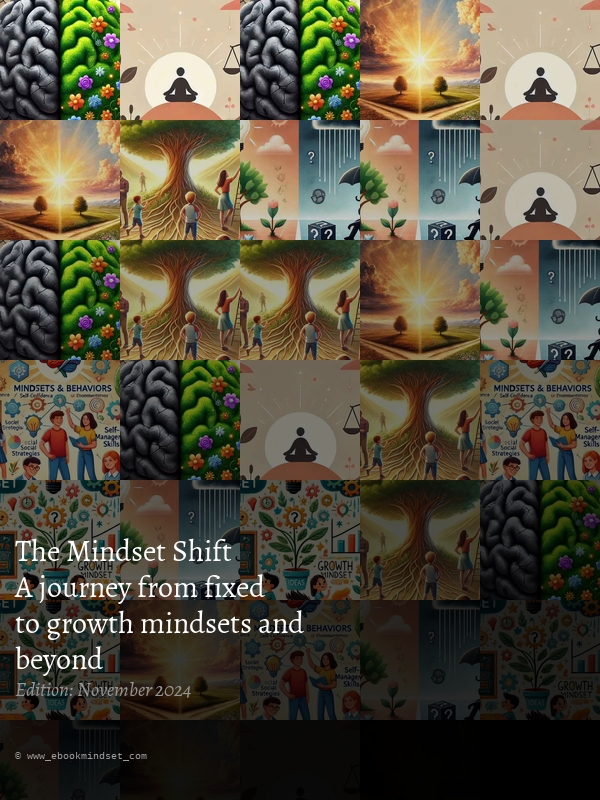Why Is It Hard to Change Your Mindset?
Changing your mindset is a challenging process, often hindered by deeply ingrained beliefs and habits. This article explores the psychological barriers, emotional attachments, and environmental factors that make it difficult, while offering practical strategies to overcome these obstacles. The journey towards a transformed perspective requires understanding the complex interplay of internal and external influences, and committing to consistent self-improvement.
The Nature of Mindsets
Mindsets are fundamental frameworks that shape our interpretation of experiences and our responses to them. They act as lenses through which we view the world, influencing our actions, decisions, and ultimately, our success. According to Carol Dweck's influential work, these are broadly categorized as fixed mindsets and growth mindsets.
A fixed mindset believes that abilities and intelligence are static and unchangeable. Individuals with a fixed mindset often avoid challenges, give up easily in the face of setbacks, and see effort as fruitless. They tend to focus on proving their intelligence rather than expanding it. In contrast, a growth mindset embraces the idea that abilities and intelligence can be developed through dedication and hard work. Those with a growth mindset view challenges as opportunities for learning and growth, persist in the face of setbacks, and see effort as the path to mastery. They focus on learning and improving rather than proving themselves.
Psychological Barriers to Change
1. Fear of the Unknown
Change, by its very nature, involves stepping outside of our comfort zones. This inherent uncertainty triggers anxiety and a natural resistance in our brains, which prioritize safety and predictability. The fear of the unknown can manifest as procrastination, avoidance, and a clinging to familiar, even if dysfunctional, patterns. Our brains are wired to avoid discomfort, and the prospect of navigating unfamiliar territory can feel overwhelming, leading to inaction and the perpetuation of limiting mindsets.
2. Cognitive Dissonance
Cognitive dissonance arises from the conflict between our beliefs and our behaviors. For example, someone might desire success but consistently engage in behaviors that hinder their progress. This discrepancy creates internal discomfort, and to alleviate this discomfort, individuals may cling to their existing mindsets, even if those mindsets are contributing to the problem. The discomfort of acknowledging the inconsistency is often greater than the discomfort of maintaining the status quo, leading to resistance to change.
3. Emotional Attachments
Our mindsets are often deeply intertwined with our emotional experiences. Mindsets formed through emotionally charged events, such as repeated failures leading to self-doubt or traumatic experiences shaping a pessimistic outlook, are particularly resistant to change. These mindsets become integral parts of our self-identity, making it emotionally challenging to let go of them. Changing these deeply ingrained beliefs requires confronting painful memories and challenging deeply held self-perceptions, making the process emotionally taxing but ultimately essential for growth.
4. Confirmation Bias
Confirmation bias is our tendency to seek out and interpret information that confirms our existing beliefs while ignoring information that contradicts them. This bias reinforces our current mindsets, making it difficult to consider alternative perspectives. We subconsciously filter information to fit our pre-existing narrative, hindering our ability to objectively assess our beliefs and their validity. Overcoming this bias requires a conscious effort to seek out diverse viewpoints and critically evaluate information from all angles.
5. Resistance to Self-Criticism
The process of changing a mindset often involves confronting uncomfortable truths about ourselves. Acknowledging our flaws and limitations can be painful, leading to resistance and a reluctance to engage in honest self-reflection. This resistance to self-criticism prevents us from identifying the root causes of our limiting beliefs and developing strategies to overcome them. Cultivating self-compassion and viewing self-criticism as a tool for growth, rather than a form of self-punishment, is crucial for effective change.
The Role of Environment
Our environments significantly influence our mindsets, both directly and indirectly. The people we surround ourselves with, the messages we receive, and the experiences we have all contribute to shaping our perspectives.
- Negative Reinforcement: Environments that consistently highlight failures, criticize efforts, or promote a culture of negativity foster fixed mindsets. Constant criticism, even well-intentioned, can erode self-confidence and reinforce a belief in one's limitations. Conversely, supportive environments that celebrate effort and learning promote growth mindsets.
- Lack of Support: Shifting perspectives is inherently difficult. Without a supportive network of friends, family, or mentors who provide encouragement, understanding, and accountability, the process becomes significantly more challenging. The lack of external validation can lead to discouragement and a relapse into old patterns of thinking.
- Social Comparison: Constant comparison to others can foster feelings of inadequacy and reinforce a fixed mindset. Social media, in particular, often presents a curated and unrealistic view of others' lives, leading to negative self-perception and a decreased willingness to embrace challenges.
Overcoming Mindset Challenges
1. Self-Reflection
Identifying limiting beliefs and their origins is the crucial first step in changing your mindset. Journaling, meditation, or simply taking time for quiet contemplation allows you to examine your thought patterns and uncover the root causes of your beliefs. Understanding where these beliefs originated can provide invaluable insight into why you think and act the way you do, paving the way for positive transformation.
2. Setting Clear Goals
Specific, measurable, achievable, relevant, and time-bound (SMART) goals provide direction and benchmarks for progress. Clear goals create a roadmap for change, making the overall process less daunting. Breaking down large, ambitious goals into smaller, manageable steps helps build momentum and maintain motivation throughout the journey. Celebrating small victories along the way reinforces a sense of accomplishment and reinforces the growth mindset.
3. Embracing Failure as Learning
A growth mindset views challenges and failures not as indicators of incompetence, but as valuable learning opportunities. Instead of dwelling on mistakes, focus on what can be learned from them and how these experiences can contribute to future success. Analyzing failures objectively allows you to identify areas for improvement, adapt your strategies, and ultimately grow stronger from setbacks.
4. Seeking Feedback
Constructive feedback from trusted sources—mentors, colleagues, or friends—offers valuable external perspectives that can highlight blind spots and areas for improvement. Openly soliciting feedback demonstrates a willingness to learn and grow, reinforcing the growth mindset. Choose sources who are known for their honesty and ability to provide constructive criticism, rather than simply those who offer affirmation.
5. Mindfulness Practices
Mindfulness practices, such as meditation and deep breathing exercises, cultivate awareness of thoughts and feelings without judgment. This increased self-awareness allows you to observe your thoughts and emotions without being swept away by them, promoting a more balanced and objective perspective. Mindfulness helps you identify and challenge negative thought patterns, allowing you to cultivate a more positive and resilient mindset.
6. Cognitive Restructuring
Cognitive restructuring involves actively challenging and replacing negative or unhelpful thoughts with more positive and realistic ones. This technique involves identifying negative thought patterns, evaluating their validity, and replacing them with more constructive and balanced perspectives. For example, if you experience a setback, instead of thinking “I’m a failure”, you could restructure this thought to “this didn’t work out as planned, but I can learn from this and try again.”
7. Positive Self-Talk
Engaging in positive self-talk involves consciously replacing negative self-criticism with encouraging and supportive self-statements. Instead of focusing on shortcomings, positive self-talk highlights strengths and accomplishments, reinforcing a sense of self-efficacy and promoting a more positive outlook. This requires consistent practice and self-awareness, but can lead to significant improvements in mood and motivation.
The Importance of Support Systems
A strong support system—comprising friends, family, mentors, or professional networks—provides invaluable encouragement, accountability, and a sense of community during the challenging process of mindset change. Sharing your goals and challenges with trusted individuals creates a sense of shared responsibility and can motivate you to stay on track. Their belief in your ability to succeed can be a powerful catalyst for transformation.
Conclusion: The Journey Towards Change
Changing your mindset is a comprehensive transformation that addresses ingrained emotional attachments, cognitive biases, and environmental influences. While challenging, understanding these dynamics empowers you to take proactive steps towards personal growth. Through consistent self-reflection, clear goal setting, reframing failure as a learning opportunity, seeking constructive feedback, embracing mindfulness practices, building a strong support system, and actively employing techniques like cognitive restructuring and positive self-talk, meaningful change is possible. The journey requires introspection, resilience, consistent effort, and a commitment to personal development. Remember that progress, not perfection, is the goal.




